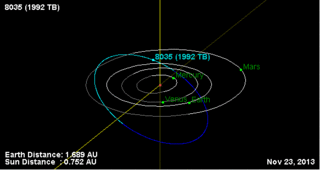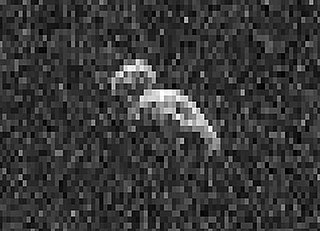
4769 Castalia is a near-Earth object and potentially hazardous asteroid of the Apollo group, approximately 1.4 kilometers in diameter and was the first asteroid to be modeled by radar imaging. It was discovered on 9 August 1989, by American astronomer Eleanor Helin (Caltech) on photographic plates taken at Palomar Observatory in California. It is named after Castalia, a nymph in Greek mythology. It is also a Mars- and Venus-crosser asteroid.
(444004) 2004 AS1, provisional designation 2004 AS1, and also known by the temporary name AL00667, is a sub-kilometer asteroid, classified as near-Earth object and potentially hazardous asteroid of the Apollo group, approximately 300 meters in diameter.
(179806) 2002 TD66 (also written 2002 TD66) is a sub-kilometer asteroid, classified as near-Earth object of the Apollo group. It was discovered on 5 October 2002, by the LINEAR project at Lincoln Laboratory's ETS in Socorro, New Mexico. It was announced on 7 October 2002 and appeared later that day on the JPL current risk page.

A potentially hazardous object (PHO) is a near-Earth object – either an asteroid or a comet – with an orbit that can make close approaches to the Earth and which is large enough to cause significant regional damage in the event of impact. They are conventionally defined as having a minimum orbit intersection distance with Earth of less than 0.05 astronomical units and an absolute magnitude of 22 or brighter, the latter of which roughly corresponds to a size larger than 140 meters. More than 99% of the known potentially hazardous objects are no impact threat over the next 100 years. As of September 2022, just 17 of the known potentially hazardous objects listed on the Sentry Risk Table could not be excluded as potential threats over the next hundred years. Over hundreds if not thousands of years though, the orbits of some "potentially hazardous" asteroids can evolve to live up to their namesake.
(163364) 2002 OD20 is an asteroid, classified as a near-Earth object and potentially hazardous asteroid of the Apollo group, likely smaller than one kilometer in diameter.
(529366) 2009 WM1, provisional designation 2009 WM1, is a sub-kilometer asteroid and near-Earth object of the Apollo group, approximately 280 meters (920 feet) in diameter. After its discovery by the Catalina Sky Survey at the Catalina Station in Arizona, United States, this potentially hazardous asteroid was briefly listed at a Torino Scale of 1 and a cumulative Palermo Scale of −0.87. It was removed from the Sentry Risk Table on 26 June 2013.
(101869) 1999 MM is a sub-kilometer asteroid on an eccentric orbit, classified as a near-Earth object and potentially hazardous asteroid of the Apollo group. It was discovered on 20 June 1999, by the Lowell Observatory Near-Earth-Object Search (LONEOS) at its U.S. Anderson Mesa Station in Flagstaff, Arizona. The first observation was made by Catalina Sky Survey just 8 days before its official discovery.
(85640) 1998 OX4 (provisional designation 1998 OX4) is a sub-kilometer asteroid, classified as near-Earth object and potentially hazardous asteroid of the Apollo group.
2011 EO40 is an asteroid, classified as a near-Earth object and a potentially hazardous asteroid of the Apollo group. It is a possible candidate for the parent body of the Chelyabinsk superbolide.
(523662) 2012 MU2, provisional designation 2012 MU2, is a sub-kilometer asteroid on an eccentric orbit, classified as near-Earth object and potentially hazardous asteroid of the Apollo group. It was discovered on 18 June 2012 by astronomers of the Catalina Sky Survey at an apparent magnitude of 19.9 using a 0.68-meter (27 in) Schmidt–Cassegrain telescope. It has an estimated diameter of 240 meters (790 ft). The asteroid was listed on Sentry Risk Table with a Torino Scale rating of 1 on 23 June 2012.

(8035) 1992 TB is an Apollo asteroid, a type of Near-Earth Object. It is also a Venus-crosser and a Mars-crosser, although it doesn't make close approaches to Mars.

(388188) 2006 DP14, provisional designation 2006 DP14, is a sub-kilometer sized, peanut-shaped asteroid on a highly eccentric orbit, classified as near-Earth object and potentially hazardous asteroid of the Apollo group. This contact binary was discovered on 23 February 2006, by astronomers of the LINEAR program at the Lincoln Laboratory's Experimental Test Site near Socorro, New Mexico, in the United States. On 10 February 2014, it passed 6.25 lunar distances from Earth. The asteroid is approximately 400 meters in diameter and has a rotation period of 5.77 hours.
2014 EC is a 10-meter sized, eccentric asteroid, classified as near-Earth object of the Apollo group that passed within 48,000 miles (77,000 km) of Earth in early March 2014. This was six times closer to the Earth than the Moon. It was first observed on 5 March 2014, by the Catalina Sky Survey at Mount Lemmon Observatory in Arizona, United States. As of 2017, it has not since been observed.
2014 XL7 is a near-Earth object and Apollo asteroid, approximately 230 meters (750 feet) in diameter. It was the most dangerous potentially hazardous asteroid on Sentry Risk Table upon its discovery by the Mount Lemmon Survey in December 2014. At the time, the asteroid had a cumulative 1 in 83000 chance of impacting Earth on 4–5 June between the years 2048 and 2084. After the object's observation arc had been extended to 35 days, it was removed from the Sentry Risk Table on 15 January 2015. Since then the asteroid's orbit has been secured. Although it has an Earth minimum orbit intersection distance of less than one lunar distance, there are no projected close encounters with Earth in the foreseeable future, with its closest passage to occur in May 2046, still millions of kilometers away.
(456938) 2007 YV56, provisional designation 2007 YV56, is a sub-kilometer asteroid on an eccentric orbit, classified as a near-Earth object and potentially hazardous asteroid of the Apollo group, approximately 190–360 meters (620–1,200 ft) in diameter. It was discovered on 31 December 2007, by astronomers of the Catalina Sky Survey conducted at the Catalina Station in Arizona, United States.
2011 GA is a small asteroid that is a Near-Earth object and an Apollo asteroid.
2012 UE34 is a sub-kilometer asteroid, classified as a near-Earth object of the Apollo group, approximately 70 meters (230 feet) in diameter. It was first observed on 18 October 2012, by Pan-STARRS at Haleakala Observatory on the island of Maui, Hawaii, in the United States. The object was removed from the Sentry Risk Table on 29 December 2013. On 8 April 2041 it will pass Earth at a nominal distance of 0.0007329 AU (110,000 km; 68,000 mi). Due to its presumed small size, it does not qualify as a potentially hazardous asteroid, despite its low Earth MOID.
(549948) 2011 WL2 is a sub-kilometer asteroid, classified as a near-Earth object and potentially hazardous asteroid of the Apollo group. It was discovered on 16 November 2011, by astronomers with the LINEAR at the Lincoln Laboratory ETS near Socorro, New Mexico, in the United States.
2019 PG1 is a sub-kilometer near-Earth object and potentially hazardous asteroid of the Apollo class, discovered by Pan-STARRS on 8 August 2019, two weeks after it passed Earth at 62 LD. With an observation arc of 103 days, Earth approach dates become divergent by 2042 as the date of closest approach in 2042 has an uncertainty of ±3 days.
2020 SL1 is a near-Earth asteroid of the Apollo group, discovered by the Pan-STARRS 1 survey at Haleakala Observatory, Hawaii on 18 September 2020. With an estimated diameter of 0.9–2.0 km (0.56–1.24 mi), it is the largest potentially hazardous asteroid discovered in 2020.




